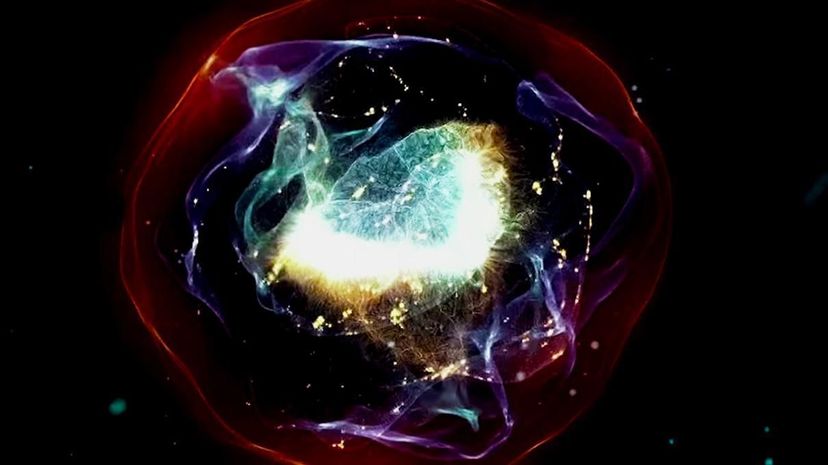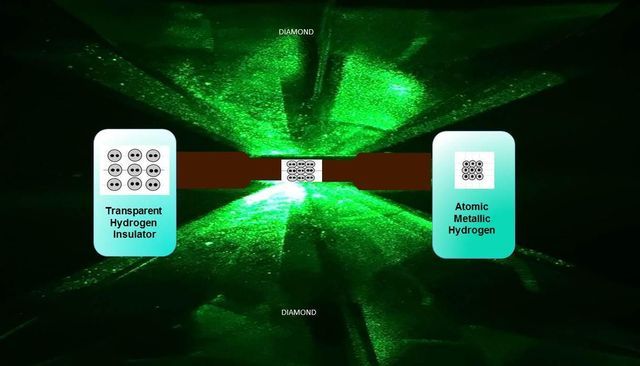Motion Detector Physics Lab Answers

Back in 1935, physicists Eugene Wigner and Hillard Bell Huntington of Princeton Academy predicted that if subjected to sufficiently intense pressure, hydrogen would get a solid metal. For the past several decades, scientists in a few elite labs around the world take been trying to accomplish just that, bombarding hydrogen with lasers and electrical pulses, and trying to squeeze information technology between diamonds.
It'due south not but curiosity that drives them. If metallic hydrogen could exist manufactured and remain stable at room temperatures, it might be an amazingly useful material. For one thing, scientists believe that it would be a superconductor, capable of allowing electrons to menstruation through it without whatever energy loss. And when heated, it would release a huge amount of energy, giving it the potential to be a game-changing propellant for rockets.
But 1 downside to metallic hydrogen? Nobody'south been able to really produce information technology — that is, evidently, until now. Harvard University researchers believe that they take created metallic hydrogen for the starting time fourth dimension in the laboratory. In an article published in the journal Science, natural science professor Isaac Silvera and research fellow Ranga Dias describe compressing hydrogen at low temperatures between specially treated synthetic diamond anvils, and observing it transition through stages — from transparent to black, and eventually to a substance that reflects light. "The backdrop are those of an atomic metal," they conclude.
Respective author Silvera didn't answer to an email, but in a Harvard YouTube video, he says: "We accept made a new material. It'south a material that never has existed on Earth before."
Others besides see the discovery as momentous.
"This paper is likely to be 1 of the nigh of import ones in physics for several decades. It solves (experimentally) a major outstanding trouble," says Jeffrey M. McMahon, an assistant professor of physics at Washington Land Academy not involved in the research, via email. "This is particularly the case if metallic hydrogen exhibits the remarkable backdrop expected." He says that metal hydrogen could turn out to be "potentially the most powerful rocket fuel known."
To create the substance, Silvera and Dias began by compressing liquid hydrogen — the element liquefies when cooled to minus 423 degrees Fahrenheit (minus 253 degrees Celsius) — in an anvil made from ii synthetic diamonds. So they turned a steel screw to exert more than and more pressure upon the liquid hydrogen.
At a pressure of virtually 2 million times that of Globe's atmosphere, the hydrogen was transparent. But once they doubled the force to four million atmospheres — more than intense than the force per unit area inside World'southward core — the hydrogen turned opaque and black. Tightening the screw even further, the hydrogen sample reflected about 90 percentage of the light that was shined upon it.

R. Dias and I.F. Silvera/Harvard University
The Harvard scientists' finding comes more than than lxxx years subsequently metallic hydrogen was get-go imagined. "It has taken so long because the force per unit area at which information technology becomes metallic is higher than was originally thought by Wigner and Huntingdon," explains Academy of Illinois professor David M. Ceperley, an expert in condensed thing physics, via email. "At pressures well-nigh 300 [atmospheres], diamonds become very susceptible to cracking, especially when hydrogen is nowadays. Many other experimentalists are surprised that Dias and Silvera were able to go up to the pressures they report successfully."
Ceperley cautions that the discovery will demand to be validated by additional research. "Even the Harvard group has not repeated information technology yet," he says. "They need to verify that what is in their cell is pure hydrogen and that the gasket material did non get dissolved in there making it metal. They demand to mensurate other properties than just optical reflectivity."
But in a contempo commodity in the periodical Nature, some scientists expressed skepticism about the discovery, saying that they wanted to see boosted proof that metal mercury really had been produced. Rivera told The New York Times he plans to perform additional measurements on the hydrogen, using a process chosen Raman scattering, which uses laser light. He likewise plans to take the sample to the U.South. authorities's Argonne National Laboratory in Illinois, where it will be probed with X-rays.
Ceperley also isn't convinced that metallic hydrogen will necessarily plough into a game-irresolute rocket fuel. He doesn't remember it will remain stable once the pressure level upon it is released, the way that a diamond does. Instead, he expects that information technology will revert to a molecular course that'south stable but at depression force per unit area. "I think the nearly likely application," he says, "is to teach u.s. how to make ameliorate superconductors out of hydrogen-containing compounds. Clearly pure metallic hydrogen by itself will be at too loftier a pressure to exist useful."
Motion Detector Physics Lab Answers,
Source: https://electronics.howstuffworks.com/future-tech/metallic-hydrogen-physics-harvard.htm
Posted by: parkerjudiction.blogspot.com


0 Response to "Motion Detector Physics Lab Answers"
Post a Comment